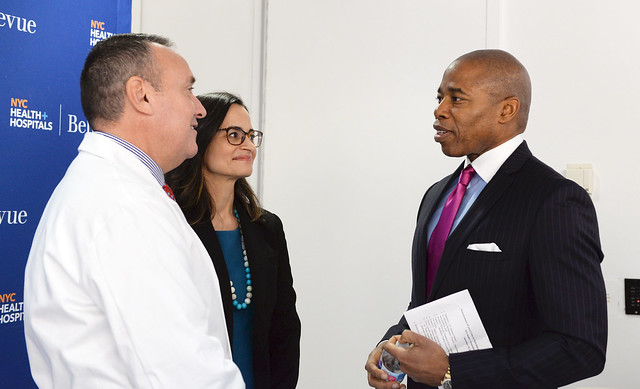
Brooklyn BP Eric Adams, the author (photo: Erica Sherman/Brooklyn BP's Office)
The world of medicine has advanced significantly in the battle against many chronic diseases, including the discovery of the polio vaccine and reversing the effects of diabetes and heart disease. However, one battle continues to be fought in research labs and on the ground in communities across America and around the world — the fight to end the HIV/AIDS epidemic.
While New York State has been a fearless leader on a national level in the effort to end this disease, Brooklyn remains the epicenter of a persistent health crisis. To tackle this head-on, the State set an ambitious goal of ending the epidemic by 2020. Thanks to the diligent work of advocates, community-based organizations, and health care providers, the target is within reach.
Yet statistics reveal a disturbing trend that must be addressed to complete the mission. Data from the New York City Department of Health and Mental Hygiene (DOHMH) reveals that 2017 HIV diagnoses were down to a record low of 2,157 citywide. Though this progress is encouraging, the rate of reduction is slowing, from an 8.6% decline in new diagnoses in 2016 to 5.4% in 2017. Brooklyn bears a disproportionate burden of the HIV/AIDS epidemic, with more than 30,000 of our neighbors living with HIV.
In 2017, our borough experienced 640 new HIV diagnoses, representing a 10.15% increase in new diagnoses from the previous year — making Brooklyn the only borough with an increase. Most alarmingly, Bedford-Stuyvesant and Crown Heights are the hardest-hit neighborhoods citywide, accounting for a quarter of new diagnoses in our borough.
Today -- Wednesday, April 10 -- we recognize National Youth HIV and AIDS Awareness Day. I continue to be concerned that each year since 2013 Brooklyn has more HIV diagnoses among youth aged 13-29 than any other borough. We owe it to our community’s young people to allow them to live in a world without AIDS.
We cannot let the promise of an end to HIV miss the mark by neglecting our most susceptible communities that have already been neglected through generational poverty, institutional racism, and unequal access to quality health care. We have tools at our disposal to end this epidemic, particularly by expanding Medicaid Special Needs Health Plans (SNPs), which are designed to address the needs of individuals living with or at higher risk for HIV. These specialized health plans help members access treatment so that the virus becomes suppressed or “undetectable,” meaning they are unable to transmit HIV to others.
The more people we help achieve undetectable status, the closer we are to a society without HIV and AIDS. SNPs also have the expertise to connect HIV-negative individuals with effective prevention methods such as pre-exposure prophylaxis (PrEP) and post-exposure prophylaxis (PEP) so they can remain negative, saving $1 billion in state Medicaid costs for every 2,000 new infections.
The sectors of the population most at risk for contracting the virus are certainly those who will benefit most from an expansion of this crucial program. The State’s “Blueprint to End the HIV/AIDS Epidemic by 2020” lists include men who have sex with men (MSM), people of transgender experience, women of color, HIV-negative partners in couples in which one person is HIV negative and the other is HIV positive, and people who are intravenous drug users as populations at higher risk for HIV.
To reduce the rate of HIV in Brooklyn and reach the 2020 eradication target, we must reach these vulnerable populations and ensure they receive the culturally competent services needed to remain HIV negative. At present, of the populations identified by the State as being at higher risk, only HIV-negative transgender individuals are currently eligible to enroll in SNPs. To reach the end of this epidemic, this must change.
Consider the clear scientific evidence that PrEP is more than 90 percent effective in preventing HIV transmission, yet the largest portion of New York State Medicaid recipients taking PrEP – 37% – are white gay and bisexual men despite black and Latino gay and bisexual men being hardest hit by the epidemic. We need to expand SNP eligibility and outreach to communities of color in the hardest-hit parts of our city to connect them to the services they need to get tested, treated, and enrolled.
We have the tools at our disposal to revolutionize the way we combat the HIV/AIDS epidemic. The power to prevent new infections is in our hands.
***
Eric L. Adams is the Brooklyn borough president. On Twitter @BPEricAdams.
***
Have an op-ed idea or submission for Gotham Gazette? Email This email address is being protected from spambots. You need JavaScript enabled to view it.